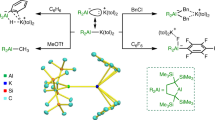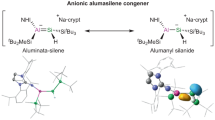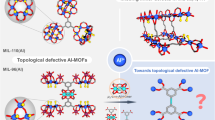Abstract
Low-valent aluminium compounds are very reactive main-group species and have therefore been widely investigated. Since the isolation of a stable molecular Al(I) compound in 1991, [(AlCp*)4] (Cp* = [C5Me5]–), a variety of highly reactive neutral or anionic low-valent aluminium complexes have been developed. By contrast, their cationic counterparts have remained difficult to access. Here, we report the synthesis of [Al(AlCp*)3]+[Al(ORF)4]– (RF = C(CF3)3) through a simple metathesis reaction between [(AlCp*)4] and Li[Al(ORF)4]. Unexpectedly, the [Al(AlCp*)3]+ salt forms a dimer in the solid state and concentrated solutions. Addition of Lewis bases results in monomerization and coordination to the unique formal Al+ atom, giving [(L)xAl(AlCp*)3]+ salts where L is hexaphenylcarbodiphosphorane (x = 1), tetramethylethylenediamine (x = 1) or 4-dimethylaminopyridine (x = 3). The Al+–AlCp* bonds in the resulting [(L)xAl(AlCp*)3]+ cluster cations can be finely tuned between very strong (with no ligand L) to very weak and approaching isolated [Al(L)3]+ ions (when L is dimethylaminopyridine).

This is a preview of subscription content, access via your institution
Access options
Access Nature and 54 other Nature Portfolio journals
Get Nature+, our best-value online-access subscription
$29.99 / 30 days
cancel any time
Subscribe to this journal
Receive 12 print issues and online access
$259.00 per year
only $21.58 per issue
Buy this article
- Purchase on Springer Link
- Instant access to full article PDF
Prices may be subject to local taxes which are calculated during checkout





Similar content being viewed by others
Data availability
X-ray crystallographic data are available free of charge from the Cambridge Crystallographic Data Centre (CCDC) under the reference numbers 2123471 (1), 2124880 (2), 2123536 (3), 2123485 (4) and 2123538 (5) via https://www.ccdc.cam.ac.uk/structures/. All other data supporting the findings are contained in the main text or the Supplementary Information. Source data are provided with this paper.
References
Dohmeier, C., Robl, C., Tacke, M. & Schnöckel, H. The tetrameric aluminum(I) compound [{Al(η5-C5Me5)}4]. Angew. Chem. Int. Ed. 30, 564–565 (1991).
Sitzmann, H., Lappert, M. F., Dohmeier, C., Üffing, C. & Schnöckel, H. Cyclopentadienylderivate von aluminium(I). J. Organomet. Chem. 561, 203–208 (1998).
Power, P. P. Main-group elements as transition metals. Nature 463, 171–177 (2010).
Weetman, C. & Inoue, S. The road travelled: after main‐group elements as transition metals. ChemCatChem 10, 4213–4228 (2018).
Chu, T. & Nikonov, G. I. Oxidative addition and reductive elimination at main-group element centers. Chem. Rev. 118, 3608–3680 (2018).
Yadav, S., Saha, S. & Sen, S. S. Compounds with low-valent p-block elements for small molecule activation and catalysis. ChemCatChem 8, 486–501 (2016).
Hobson, K., Carmalt, C. J. & Bakewell, C. Recent advances in low oxidation state aluminium chemistry. Chem. Sci. 11, 6942–6956 (2020).
Roesky, H. W. & Kumar, S. S. Chemistry of aluminium(I). Chem. Commun. (2005).
Weetman, C., Xu, H. & Inoue, S. in Encyclopedia of Inorganic and Bioinorganic Chemistry (ed. Scott, R. A.) 1–20 (Wiley, 2011).
Schnepf, A. & Schnöckel, H. Metalloid aluminum and gallium clusters: element modifications on the molecular scale? Angew. Chem. Int. Ed. 41, 3532–3554 (2002).
Schnöckel, H. Metalloid Al- and Ga-clusters: a novel dimension in organometallic chemistry linking the molecular and the solid-state areas? Dalton Trans. (2005).
Ecker, A., Weckert, E. & Schnöckel, H. Synthesis and structural characterization of an AI77 cluster. Nature 387, 379–381 (1997).
Vollet, J., Hartig, J. R. & Schnöckel, H. Al50C120H180: a pseudofullerene shell of 60 carbon atoms and 60 methyl groups protecting a cluster core of 50 aluminum atoms. Angew. Chem. Int. Ed. 43, 3186–3189 (2004).
Cui, C. et al. Synthesis and structure of a monomeric aluminum(I) compound [{HC(CMeNAr)2}Al] (Ar=2,6–iPr2C6H3): a stable aluminum analogue of a carbene. Angew. Chem. Int. Ed. 39, 4274–4276 (2000).
Hofmann, A., Tröster, T., Kupfer, T. & Braunschweig, H. Monomeric Cp3tAl(i): synthesis, reactivity, and the concept of valence isomerism. Chem. Sci. 10, 3421–3428 (2019).
Hicks, J., Vasko, P., Goicoechea, J. M. & Aldridge, S. The aluminyl anion: a new generation of aluminium nucleophile. Angew. Chem. Int. Ed. 60, 1702–1713 (2021).
Hicks, J., Vasko, P., Goicoechea, J. M. & Aldridge, S. Synthesis, structure and reaction chemistry of a nucleophilic aluminyl anion. Nature 557, 92–95 (2018).
Roy, M. M. D. et al. Probing the extremes of covalency in M–Al bonds: lithium and zinc aluminyl compounds. Angew. Chem. Int. Ed. 60, 22301–22306 (2021).
Hicks, J., Vasko, P., Goicoechea, J. M. & Aldridge, S. Reversible, room-temperature C–C bond activation of benzene by an isolable metal complex. J. Am. Chem. Soc. 141, 11000–11003 (2019).
Schwamm, R. J., Anker, M. D., Lein, M. & Coles, M. P. Reduction vs. addition: the reaction of an aluminyl anion with 1,3,5,7-cyclooctatetraene. Angew. Chem. Int. Ed. 58, 1489–1493 (2019).
Schwamm, R. J. et al. A stable calcium alumanyl. Angew. Chem. Int. Ed. 59, 3928–3932 (2020).
Grams, S., Eyselein, J., Langer, J., Färber, C. & Harder, S. Boosting low-valent aluminum(I) reactivity with a potassium reagent. Angew. Chem. Int. Ed. 59, 15982–15986 (2020).
Kurumada, S., Takamori, S. & Yamashita, M. An alkyl-substituted aluminium anion with strong basicity and nucleophilicity. Nat. Chem. 12, 36–39 (2020).
Koshino, K. & Kinjo, R. Construction of σ-aromatic AlB2 ring via borane coupling with a dicoordinate cyclic (alkyl)(amino)aluminyl anion. J. Am. Chem. Soc. 142, 9057–9062 (2020).
Roy, M. M. D., Heilmann, A., Ellwanger, M. A. & Aldridge, S. Generation of a π-bonded isomer of P44− by aluminyl reduction of white phosphorus and its ammonolysis to PH3. Angew. Chem. Int. Ed. 60, 26550–26554 (2021).
Anker, M. D., McMullin, C. L., Rajabi, N. A. & Coles, M. P. Carbon–carbon bond forming reactions promoted by aluminyl and alumoxane anions: introducing the ethenetetraolate ligand. Angew. Chem. Int. Ed. 59, 12806–12810 (2020).
Evans, M. J., Anker, M. D., McMullin, C. L., Neale, S. E. & Coles, M. P. Dihydrogen activation by lithium- and sodium-aluminyls. Angew. Chem. Int. Ed. 60, 22289–22292 (2021).
Koshino, K. & Kinjo, R. Fragmentation of white phosphorus by a cyclic (alkyl)(amino)alumanyl anion. Organometallics 39, 4183–4186 (2020).
Kurumada, S., Sugita, K., Nakano, R. & Yamashita, M. A meta-selective C–H alumination of mono-substituted benzene by using an alkyl-substituted Al anion through hydride-eliminating SN Ar reaction. Angew. Chem. Int. Ed. 59, 20381–20384 (2020).
Queen, J. D., Lehmann, A., Fettinger, J. C., Tuononen, H. M. & Power, P. P. The monomeric alanediyl:AlAriPr8 (AriPr8 = C6H-2,6-(C6H2-2,4,6-Pri3)2-3,5-Pri2): an organoaluminum(I) compound with a one-coordinate aluminum atom. J. Am. Chem. Soc. 142, 20554–20559 (2020).
Hinz, A. & Müller, M. P. Attempted reduction of a carbazolyl-diiodoalane. Chem. Commun. 57, 12532–12535 (2021).
Zhang, X. & Liu, L. L. A free aluminylene with diverse σ-donating and doubly σ/π-accepting ligand features for transition metals. Angew. Chem. Int. Ed. 60, 27062–27069 (2021).
Zhang, X. & Liu, L. L. Modulating the frontier orbitals of an aluminylene for facile dearomatization of inert arenes. Angew. Chem. Int. Ed. (2022).
Queen, J. D., Irvankoski, S., Fettinger, J. C., Tuononen, H. M. & Power, P. P. A monomeric aluminum imide (iminoalane) with Al–N triple-bonding: bonding analysis and dispersion energy stabilization. J. Am. Chem. Soc. 143, 6351–6356 (2021).
Klemp, C., Stößer, S., Krossing, I. & Schnöckel, H. Al5Br7⋅5 THF—the first saltlike aluminum subhalide. Angew. Chem. Int. Ed. 39, 3691–3694 (2000).
Franz, D. & Inoue, S. Cationic complexes of boron and aluminum: an early 21st century viewpoint. Chem. Eur. J. 25, 2898–2926 (2019).
Dabringhaus, P., Barthélemy, A. & Krossing, I. The coordination chemistry and clustering of subvalent Ga+ and In+ upon addition of σ‐donor ligands. Z. Anorg. Allg. Chem. (2021).
Glootz, K. et al. Why do five Ga+ cations form a ligand-stabilized Ga55+ pentagon and how does a 5:1 salt pack in the solid state? Angew. Chem. Int. Ed. 58, 14162–14166 (2019).
Higelin, A., Keller, S., Göhringer, C., Jones, C. & Krossing, I. Unusual tilted carbene coordination in carbene complexes of gallium(I) and indium(I). Angew. Chem. Int. Ed. 52, 4941–4944 (2013).
Higelin, A., Sachs, U., Keller, S. & Krossing, I. Univalent gallium and indium phosphane complexes: from pyramidal M(PPh3)3(+) to carbene-analogous bent M(PtBu3)2(+) (M=Ga, In) complexes. Chem. Eur. J. 18, 10029–10034 (2012).
Lichtenthaler, M. R. et al. Cationic cluster formation versus disproportionation of low-valent indium and gallium complexes of 2,2′-bipyridine. Nat. Commun. 6, 8288 (2015).
Wehmschulte, R. J., Peverati, R. & Powell, D. R. Convenient access to gallium(I) cations through hydrogen elimination from cationic gallium(III) hydrides. Inorg. Chem. 58, 12441–12445 (2019).
Inomata, K., Watanabe, T., Miyazaki, Y. & Tobita, H. Insertion of a cationic metallogermylene into E–H bonds (E = H, B, Si). J. Am. Chem. Soc. 137, 11935–11937 (2015).
Morris, L. J., Carpentier, A., Maron, L. & Okuda, J. Reductive elimination of [AlH2]+ from a cationic Ga–Al dihydride. Chem. Commun. 57, 9454–9457 (2021).
Ganesamoorthy, C. et al. Reductive elimination: a pathway to low-valent aluminium species. Chem. Commun. 49, 2858–2860 (2013).
Purath, A. & Schnöckel, H. Tetrakis[tris(trimethylsilyl)silylaluminium(I)] Al4[Si(SiMe3)3]4—eine siliziumreicheVerbindung mit zentralem tetraedrischem Al4-Kern. J. Organomet. Chem. 579, 373–375 (1999).
Schnepf, A., Köppe, R. & Schnöckel, H. A Ga8R6 cluster as an ideal model for a metal–metal bond? Angew. Chem. Int. Ed. 40, 1241–1243 (2001).
Purath, A. et al. Synthesis and structure of a neutral SiAl14 cluster. J. Am. Chem. Soc. 122, 6955–6959 (2000).
Schnöckel, H. Decamethylaluminocenium, a π‐stabilized R2Al+ cation. Angew. Chem. Int. Ed. 32, 1655–1657 (1993).
Buchin, B., Gemel, C., Cadenbach, T., Schmid, R. & Fischer, R. A. The Ga2(C5Me5)+ ion: bipyramidal double-cone structure and weakly coordinated, monovalent Ga+. Angew. Chem. Int. Ed. 45, 1074–1076 (2006).
Jones, J. N., Macdonald, C. L., Gorden, J. D. & Cowley, A. H. Use of a smaller counterion results in an ‘inverse sandwich’ diindium cation. J. Organomet. Chem. 666, 3–5 (2003).
Mellerup, S. K. et al. Lewis-base stabilization of the parent Al(I) hydride under ambient conditions. J. Am. Chem. Soc. 141, 16954–16960 (2019).
Petz, W., Kutschera, C., Tschan, S., Weller, F. & Neumüller, B. Umsetzung von Ph3P=C=PPh3 mit Lewis-säuren von hauptgruppenelementen; synthesen, strukturen und reaktionen der additionsverbindungen [Br3Al{C(PPh3)2}] und [Me3In{C(PPh3)2}]. Z. Anorg. Allg. Chem. 629, 1235–1244 (2003).
Quinlivan, P. J., Shlian, D. G., Amemiya, E. & Parkin, G. Reactivity of the carbodiphosphorane, (Ph3P)2C, towards main group metal alkyl compounds: coordination and cyclometalation. Dalton Trans. 48, 9139–9151 (2019).
Vranka, R. G. & Amma, E. L. Crystal structure of trimethylaluminum. J. Am. Chem. Soc. 89, 3121–3126 (1967).
Thermodynamics computed at bp86-d3bj/def2-svp level of DFT. The breakup of [(AlCp*)4] into an AlCp* monomer and an [(AlCp*)3] trimer was computed to ΔG01,2-DFB = 150 kJ mol-1.
Zhao, L., Hermann, M., Schwarz, W. H. E. & Frenking, G. The Lewis electron-pair bonding model: modern energy decomposition analysis. Nat. Rev. Chem. 3, 48–63 (2019).
Roesky, H. W. & Kennepohl, D. K. Experiments in Green and Sustainable Chemistry (Wiley-VCH, 2009).
Gruber, M., Bauer, W., Maid, H., Schöll, K. & Tykwinski, R. R. Synthetic and NMR studies on hexaphenylcarbodiphosphorane (Ph3PCPPh3). Inorg. Chim. Acta 468, 152–158 (2017).
Pranckevicius, C., Iovan, D. A. & Stephan, D. W. Three and four coordinate Fe carbodiphosphorane complexes. Dalton Trans. 45, 16820–16825 (2016).
Acknowledgements
We thank the Fonds of the Chemical Industry for a fellowship for P.D., the German Research Foundation for the funding of project KR2046/35-1 and the Albert Ludwig University of Freiburg for supporting the work. We thank M. Schmitt and B. Butschke for fruitful dialogue and advice on quantum-chemical calculations and single-crystal X-ray diffraction crystallography. We acknowledge T. Ludwig and M. Daub for measurement of powder X-ray diffraction and H. Scherer and F. Bitgül for measurement of NMR spectra. Furthermore, we acknowledge support by the state of Baden-Württemberg through bwHPC and the German Research Foundation through grant no. INST 40/575-1 FUGG (JUSTUS 2 cluster).
Author information
Authors and Affiliations
Contributions
P.D. and J.W. planned and carried out all experiments and analysed the data. P.D. carried out the single-crystal X-ray diffraction measurements and the mass spectrometry measurements and conducted the computational investigations. P.D. and I.K. wrote the manuscript.
Corresponding author
Ethics declarations
Competing interests
The authors declare no competing interests.
Peer review
Peer review information
Nature Chemistry thanks Sakya Sen and the other, anonymous, reviewer(s) for their contribution to the peer review of this work.
Additional information
Publisher’s note Springer Nature remains neutral with regard to jurisdictional claims in published maps and institutional affiliations.
Supplementary information
Supplementary Information
Supplementary Figs. 1–94, Tables 1–40, Discussion, all coordinates of optimized structures listed along with vibrational frequencies and refs. 1–56.
Supplementary Data 1
Crystallographic data for compound 1, CCDC 2123471.
Supplementary Data 2
Crystallographic data for compound 2, CCDC 2124880.
Supplementary Data 3
Crystallographic data for compound 3, CCDC 2123536.
Supplementary Data 4
Crystallographic data for compound 4, CCDC 2123485.
Supplementary Data 5
Crystallographic data for compound 5, CCDC 2123538.
Supplementary Data 6
Source data of Supplementary Fig. 76.
Supplementary Data 7
Source data of Supplementary Fig. 77.
Source data
Source Data Fig. 2c
NMR data for Fig. 2c.
Source Data Fig. 2f
UVVIS data for figure 2f.
Rights and permissions
About this article
Cite this article
Dabringhaus, P., Willrett, J. & Krossing, I. Synthesis of a low-valent Al4+ cluster cation salt. Nat. Chem. 14, 1151–1157 (2022). https://doi.org/10.1038/s41557-022-01000-4
Received:
Accepted:
Published:
Issue Date:
DOI: https://doi.org/10.1038/s41557-022-01000-4



